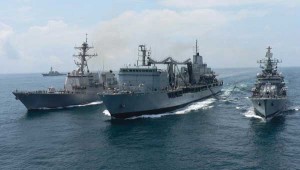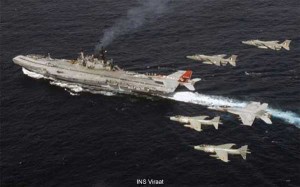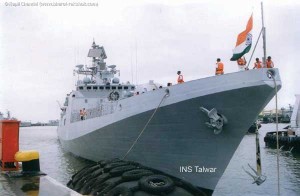US-India Military Relationship
To continue with a related topic, the common strategic interests of the US and India have been much spoken about. But there has been little to show by way of naval cooperation other than the emphasis on interoperability. What are the possible further dimensions of naval cooperation between the Indian and US Navies?
India-US naval cooperation has increased significantly over the last decade. Our navies have skills in a number of diverse areas of war-fighting. By working with a technologically advanced navy with a global presence, we have been able to share and imbibe current tactical, technological practices and techniques. A spin-off of our interaction with the US Navy has assisted in shaping the perceptions of other navies of the Indian Navy as a competent, confident and stabilising force in the Indian Ocean Region.
“A spin-off of our interaction with the US Navy has assisted in shaping the perceptions of other navies of the Indian Navy”¦”
Our operational interaction with the US Navy has steadily grown to include war-games, exercises and operations at various levels. The operational interaction between the two navies has been institutionalised at the following levels:-
- Defence Policy Group (DPG) at the apex level that is steered by the Defence Secretary, and Defence Procurement Policy Group (DPPG) steered by DG (Acquisition).
- Military Cooperation Group (MCG) for overall defence cooperation steered by HQIDS on our side and the Pentagon.
- Executive Steering Group (ESG) for Navy-to-Navy cooperation steered by DCNS and Commander, US Seventh Fleet.
- Joint Technical Group (JTG) for Defence Research and Production cooperation.
 IN-USN Bilateral Exercise. IN-USN bilateral exercises are an expression of the serious intent with which both navies seek to engage with each other. It is not just about interoperability but also about laying the foundation for a robust relationship, that is built on mutual trust and understanding. The two navies engage each other through a series of exercises which are conducted annually at US and Indian locations.
IN-USN Bilateral Exercise. IN-USN bilateral exercises are an expression of the serious intent with which both navies seek to engage with each other. It is not just about interoperability but also about laying the foundation for a robust relationship, that is built on mutual trust and understanding. The two navies engage each other through a series of exercises which are conducted annually at US and Indian locations.
The MALABAR series of exercises have been being conducted since 1992, with participation of ships, submarines and aircraft from both the sides. MALABAR 2010 is scheduled to be held off the Indian coast in end April this year. The other interactions that are progressed between the two navies include:-
- IN – USN Explosives Ordnance Disposal exercise that involves surface and underwater explosive ordnance disposal serials, heliborne ops, etc.
- A salvage exercise is conducted annually alternating between an Indian and US location, wherein the diving teams from both the navies conduct salvage operations.
- An Expeditionary Warfare table top exercise, conducted annually with participation from the elements of all the three Indian Armed Forces.
The above operational engagements have allowed the Indian Navy to closely observe operations conducted by the US Navy and have assisted in achieving the following additional objectives.:-
“Our vast 7,516.6 km coastline with 13 major and 200 minor ports and innumerable landing places, makes it an extremely difficult task for any single agency to handle on its own.”
- Gaining operational and doctrinal expertise.
- Sharing transformational experience.
- Examining and imbibing the ‘best-practices’.
- Enhancing inter-operability to assist in out-of-area contingencies/operations.
- Enhancing Indian Navy’s Maritime Domain Awareness through information-sharing mechanisms.
US-Indian Navy interface has also extended into the operational and training domain. The integration of MIG 29K carrier borne aircraft with Vikramaditya required the Indian Navy to re-learn the intricacies of ‘arrested wire recovery’ that had been lost when the navy phased out its Sea Hawks and Alizes carrier borne aircraft in favour of the vertical landing Sea Harriers. Over the past few years some of our young aviators have trained with the US Navy, for ‘Arrested Landing’ conversion. They would be the ones who would be critical for developing our operational capability, when Vikramaditya joins the Fleet and the Russian built MIG 29K aircraft are flying from her deck. So we have cooperation with the US, which would ultimately help us exploit Russian hardware.
 There are also other aspects of force capability enhancement, such as the purchase of INS Jalashwa (Ex-USS Trenton), and the impending induction of the sophisticated P-8I “Poseidon” Maritime Patrol Aircraft (MPA), which are examples of naval cooperation between the US and India.
There are also other aspects of force capability enhancement, such as the purchase of INS Jalashwa (Ex-USS Trenton), and the impending induction of the sophisticated P-8I “Poseidon” Maritime Patrol Aircraft (MPA), which are examples of naval cooperation between the US and India.
The US and Indian Navies also have a lot in common at the doctrinal level. A Cooperative Strategy for 21st Century Sea Power of the US unveiled by the current CNO USN and Commandants US Marine Corps (USMC) and US Coast Guard (USCG) in end 2007, emphasises the need for constructive engagement to face up to the current challenges of maritime security. The Indian Navy also sees the imperatives of cooperation between navies to confront non-traditional threats, as clearly enunciated in our documents Freedom to Use the Seas: India’s Maritime Military Strategy and the Indian Maritime Doctrine 2009.
 Sharing maritime information undoubtedly will be a major focus area for the two navies to further consolidate our relationship. We have common concerns regarding piracy, maritime terrorism, smuggling and other nefarious activities at sea. Maritime Domain Awareness, thus, will be one of the key result areas. It is in these areas that the two navies will find greater scope for cooperation.
Sharing maritime information undoubtedly will be a major focus area for the two navies to further consolidate our relationship. We have common concerns regarding piracy, maritime terrorism, smuggling and other nefarious activities at sea. Maritime Domain Awareness, thus, will be one of the key result areas. It is in these areas that the two navies will find greater scope for cooperation.
We envision tackling the myriad challenges to maritime security as equal partners, and are putting into place mechanisms that will address our common concerns, while keeping due regard for individual national interests and sensitivities. As is already known, the Indo-US “Framework for Maritime Security Cooperation”, signed in 02 Mar 2006 by Prime Minister Manmohan Singh and President George Bush charts the course for us.




